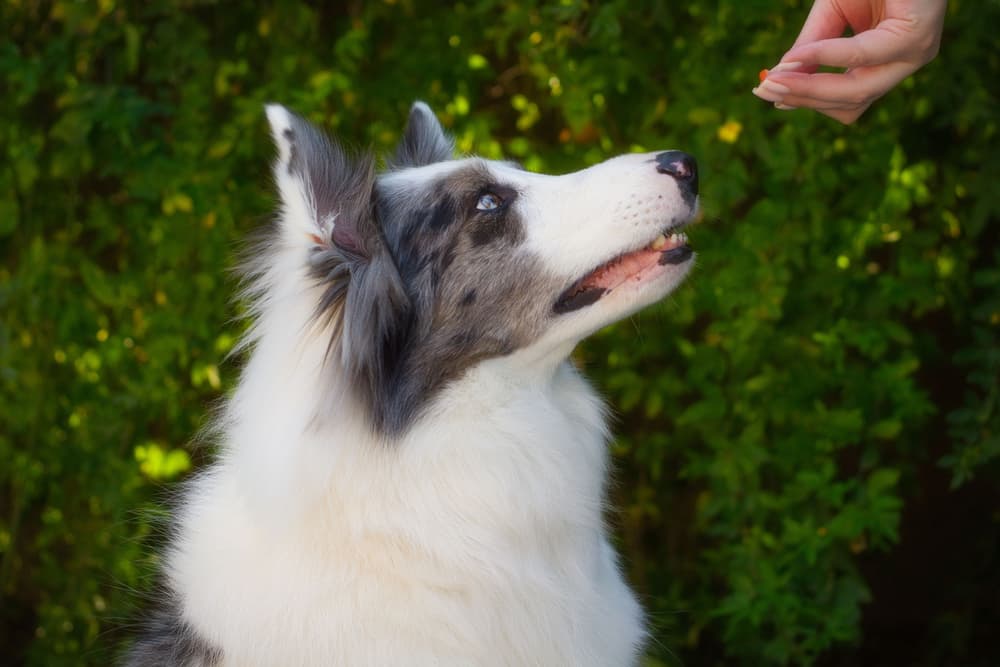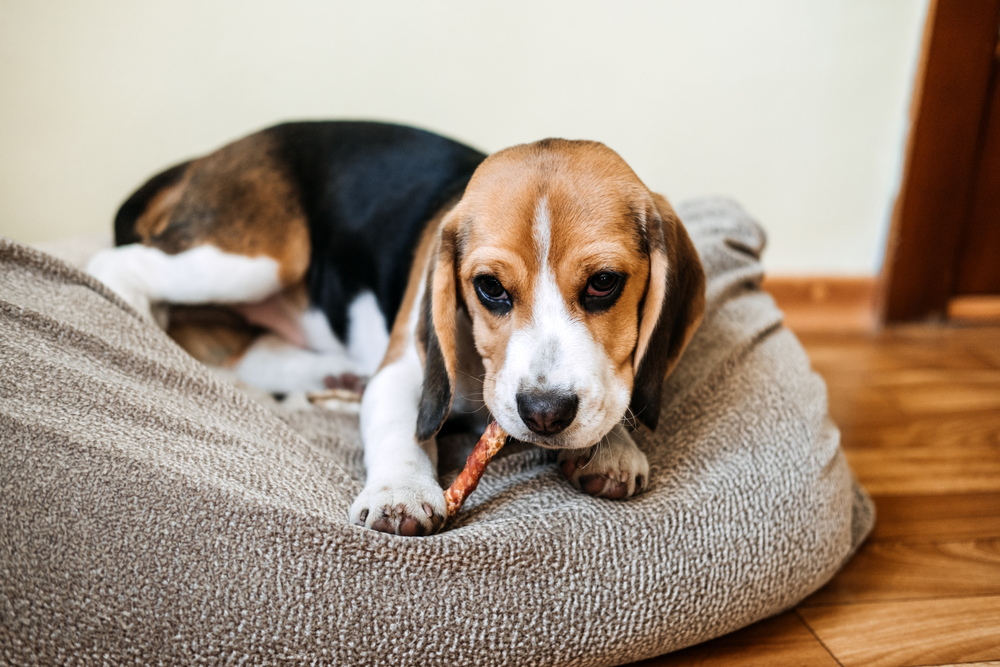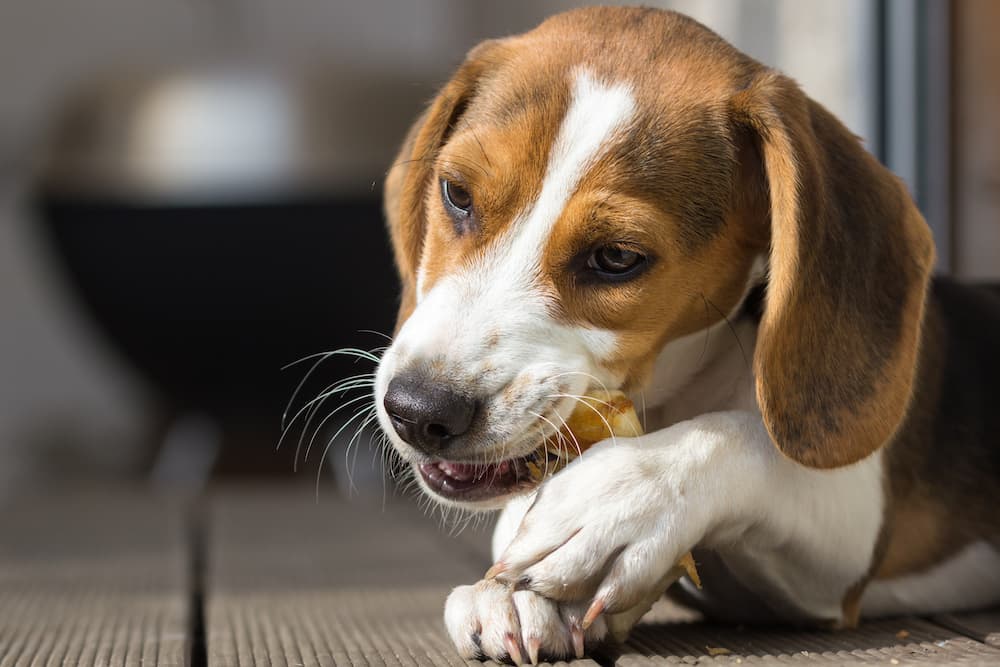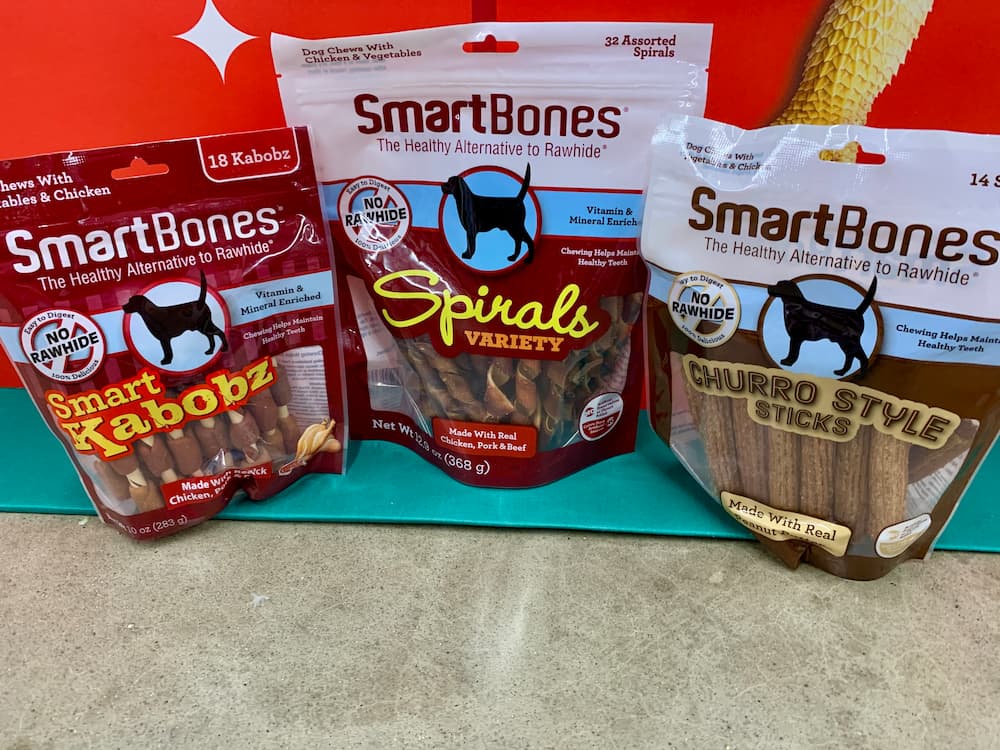12 Best Dog Treats for Bad Breath of 2025
Published on May 11, 2022
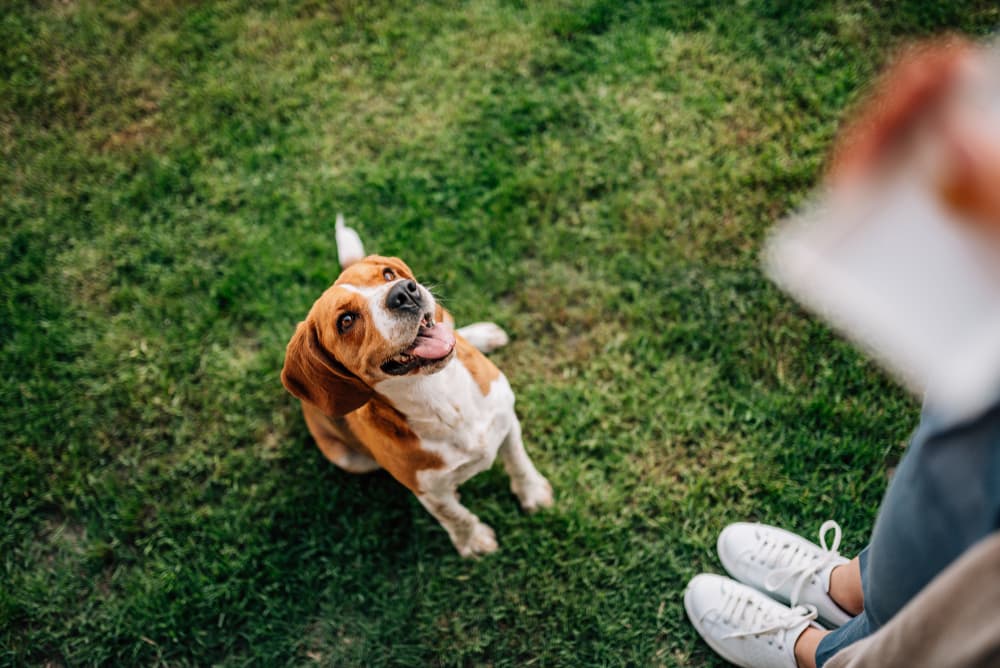
Bad breath is no fun. Imagine you’re sitting on the couch when your dog hops up beside you and gives you that look that says “pet me.” So, of course, you oblige. Before long, their tail is wagging, and then they open their mouth to pant a little, and you catch a whiff of their breath. And it’s BAD.
Of course the last thing you want to do is push your pup away, but their breath is just so stinky you don’t think you can sit there for another minute, breathing it in. What do you do?
Well here’s good news: there are plenty of dog treats for bad breath that can banish unpleasant odors. They’re basically like breath mints for dogs. In fact, some even help clean your pup’s teeth by attacking the root cause of the stink.
Our Winners
All featured products are chosen at the discretion of the Vetstreet editorial team and do not reflect a direct endorsement by the author. However, Vetstreet may make a small affiliate commission if you click through and make a purchase.
- Best Overall Dog Treats for Bad Breath: Greenies Regular Dental Dog Treats
- Best Dog Dental Chews for Bad Breath: OraVet Hygiene Dental Chews
- Best Functional Dog Treats for Bad Breath: Zesty Paws All-in-One FUNctional Dental Bones
- Safest Dental Chew for Easy Digestion: Better Belly Triple Action Ridges
- Best Dog Dental Sticks for Bad Breath: Bark Bright Dental Chews
- Best Large Dog Treats for Bad Breath: Pedigree Dentastix Large Fresh Dog Treats
- Best Grain-Free Treats for Bad Breath: Pet Naturals Breath Bites Dog Chews
- Best Crunchy Dog Treats for Bad Breath: Bocce’s Bakery Daily Support Dog Treat
- Best Dog Treats for Puppy Breath: WholeHearted Smart Smiles Dental Treats for Puppies
- Best Treats for Senior Dogs with Bad Breath: Ark Naturals Gray Muzzle Brushless Toothpaste Senior Dental Dog Treats
- Best Baking Soda Dog Treats for Fresh Breath: Arm & Hammer for Pets Dental Mints for Dogs
- Most Affordable Dog Treats for Bad Breath: Milk-Bone Fresh Breath Brushing Chews Daily Dental Dog Treats
Best Dog Treats for Bad Breath
It’s worth noting that if your dog has diabetes, kidney disease, liver disease, or severe dental disease, treats and chews might only provide temporary or mild breath freshening.
Best Overall Dog Treats for Bad Breath
Our Pick: Greenies Regular Dental Dog Treats
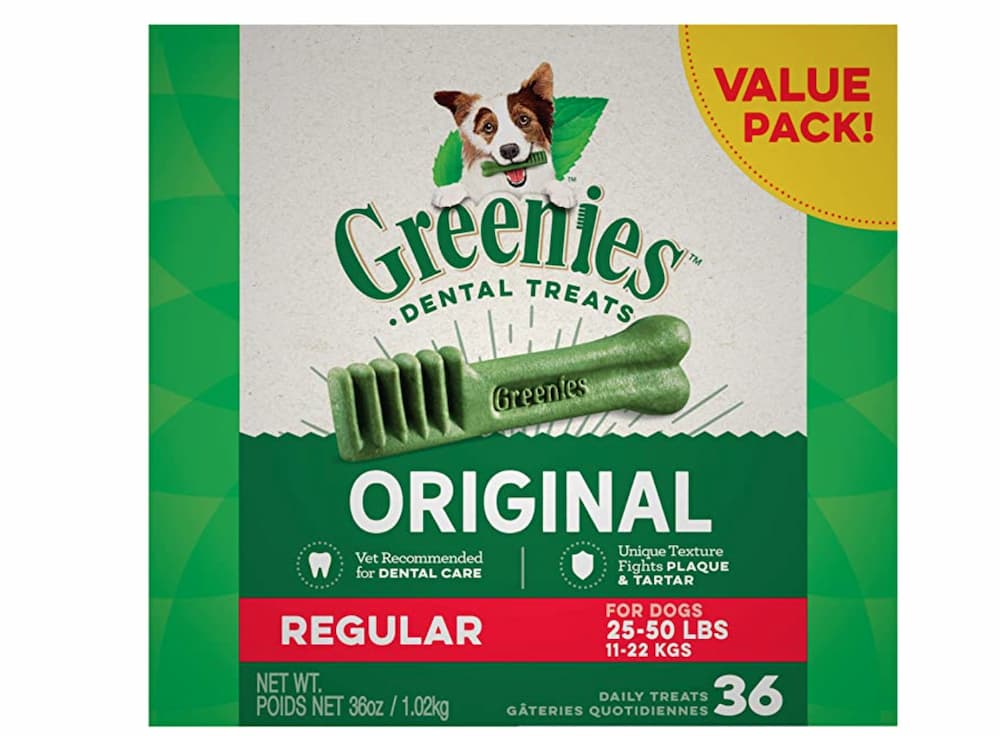
Greenies are one of the best-known brands of dog treats for bad breath, and with good reason. Available in four different sizes and multiple box sizes to fit your needs, these treats are designed to clean your pup’s teeth and freshen their breath. The treats are soft enough to suit a variety of dogs, while also featuring a unique texture to help clean a dog’s mouth. Plus the treats are veterinarian-recommended and have the Veterinary Oral Health Council (VOHC) seal of approval.
Highlights
- These treats have the VOHC seal of approval
- Available in different treat sizes and box sizes
- Easy to find at pet stores and online
- Well-known brand
- Can be given daily
- Contain vitamins, minerals, and other nutrients
- Soft texture prevents injury to gums
- Made in the USA
Things to Consider
- Some dogs eat these treats for dog breath too quickly rather than chew them for a while, making them less effective
- The green color is off-putting to some pet parents
Best Dog Dental Chews for Bad Breath
Our Pick: OraVet Hygiene Dental Chews
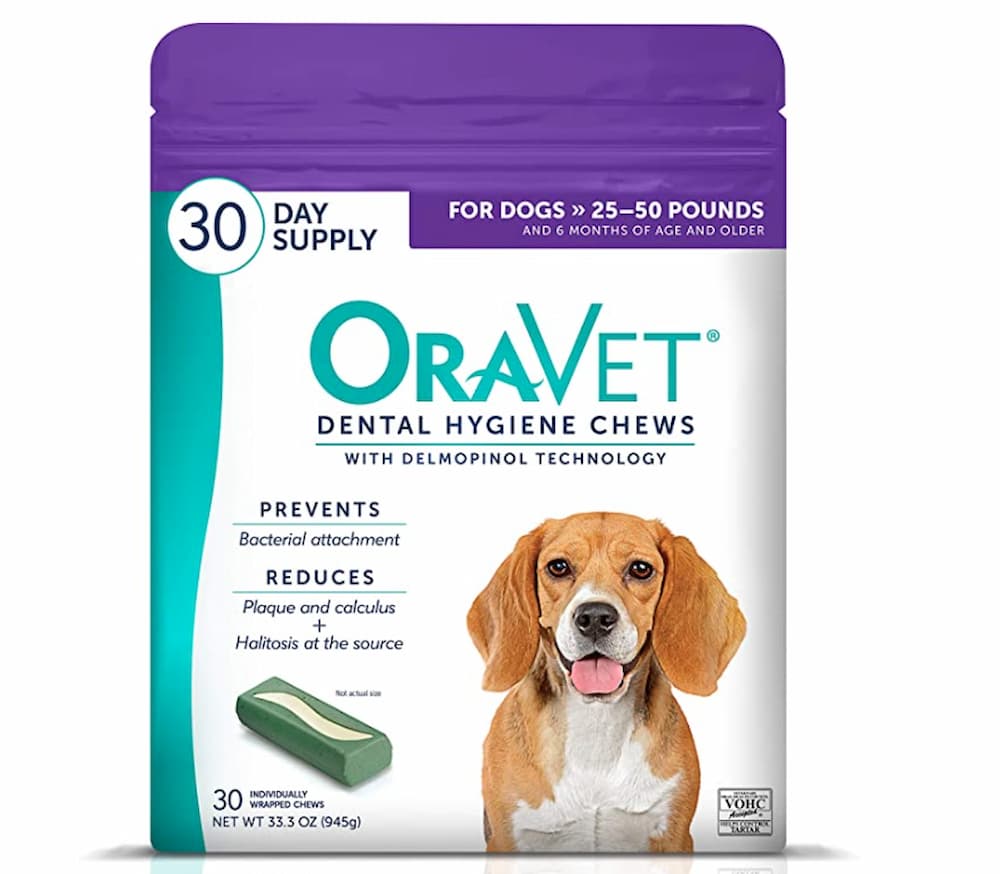
If your pup has bad breath, these treats might be the answer because they are one of the only veterinarian-recommended dental chews that contain delmopinol, an ingredient found in human dental products. This ingredient helps form a barrier around your dog’s teeth and protects against the bacteria that leads to bad breath. The dog chews for bad breath also help dislodge plaque, so they’ll help keep your dog’s teeth clean too.
Highlights
- Available in a variety of different sizes for different breeds
- Veterinarian-recommended
- Contains delmopinol, an ingredient that helps protect against bad breath
- Can be given daily
- Helps dislodge plaque and minimize dental disease
- Made in the USA
- Each treat is individually wrapped for freshness
- VOHC accepted
Things to Consider
- Relatively pricey
- Make sure you pick the right size treat for your dog’s weight to minimize choking risk
- Some dogs get green poop
- Some pups tend to eat these treats for dog breath quickly
- Not for puppies under the age of 6 months
Best Functional Dog Treats for Bad Breath
Our pick: Zesty Paws All-in-One FUNctional Dental Bones
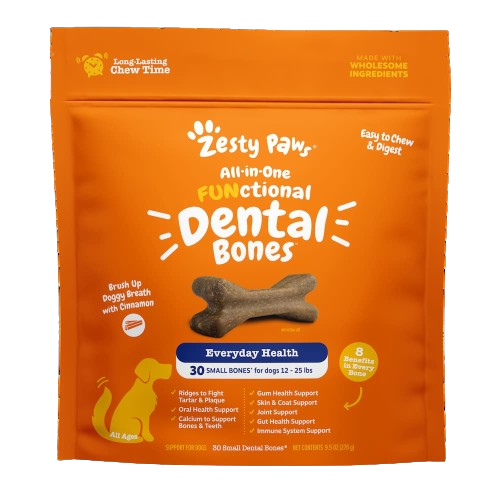
These all-in-one functional dental bones from Zesty Paws do way more than just banish bad breath—they’re designed to support your pup’s everyday health. In addition to breath-freshening cinnamon, these long-lasting dog breath treats contain calcium to support bones and teeth, inulin for gut health, and omega-3 fatty acids for skin, coat, joint, and immune support. They also have a ridged texture that gets in between teeth to fight tartar and plaque. Now that’s something to smile about!
Highlights
- Eight benefits in every bone
- These dog bones for bad breath are available in three sizes: Small (for dogs 12-25 pounds); Medium (for dogs 25-35 pounds); or Large (for dogs 35 pounds and up)
- Comes with a 100% satisfaction guarantee
- Certified by the National Animal Supplement Council (NASC)
Things to Consider
- Number of bones per bag depends on whether you are purchasing small, medium or large bones (Small: 28ct or 78ct bags; Medium: 12ct or 36ct bags; Large: 8ct or 24ct bags)
- The brand suggests starting with one bone per day to get your dog used to the ingredients. From there, you should not exceed two bones a day
- The bones are designed to be easy to chew, but you should still keep an eye on your pup to ensure safe chewing and consumption
- Intended for intermittent or supplemental feeding only
Safest Dental Chew for Easy Digestion
Our pick: Better Belly Triple Action Ridges
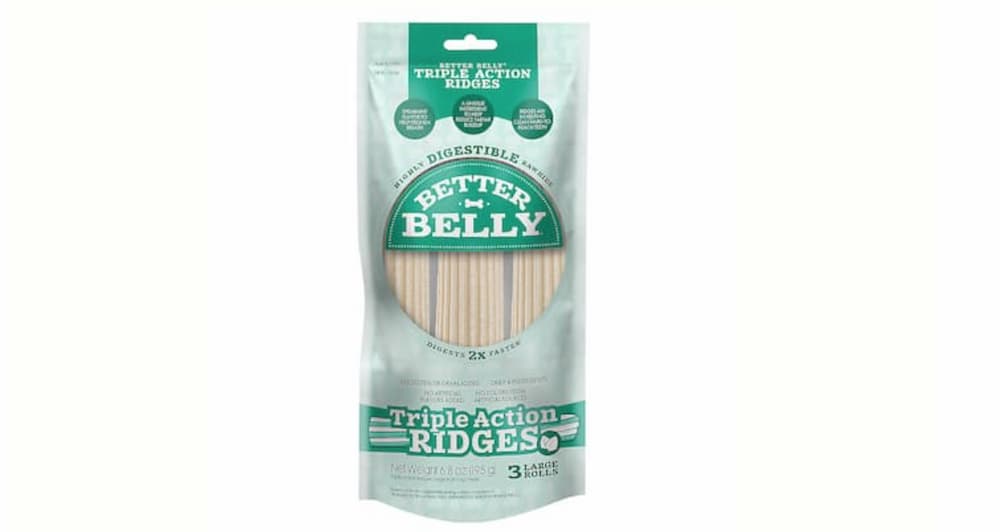
Your dog wants a satisfying dental chew, but you don’t want to upset their stomach. Better Belly’s Highly Digestible Triple Action Ridges digest two times faster than other dental chews and has no artificial colors or flavors. Made of rawhide and infused with natural spearmint flavor, your pup can chew to their heart’s content for fresh, clean breath with easier digestion.
Highlights
- The proprietary manufacturing process helps rawhide fibers break down and digest two times faster than standard rawhide
- Each roll contains ridges to help clean hard-to-reach areas as your dog gnaws and chews
- Helps reduce tartar buildup and helps freshen your dog’s breath
- Contains no artificial flavors, colors, or preservatives
- Gluten-free and grain-free
- Contains minimal ingredients: rawhide, gelatin, natural spearmint flavor, and a unique ingredient to help reduce tartar buildup
Things to Consider
- Intended for intermittent or supplemental feeding only
- Three chews per pack
- As with any treat, monitor your dog during chewing activity and discard any leftover chunks or fragments
Best Dog Dental Sticks for Bad Breath
Our Pick: Bark Bright Dental Chews
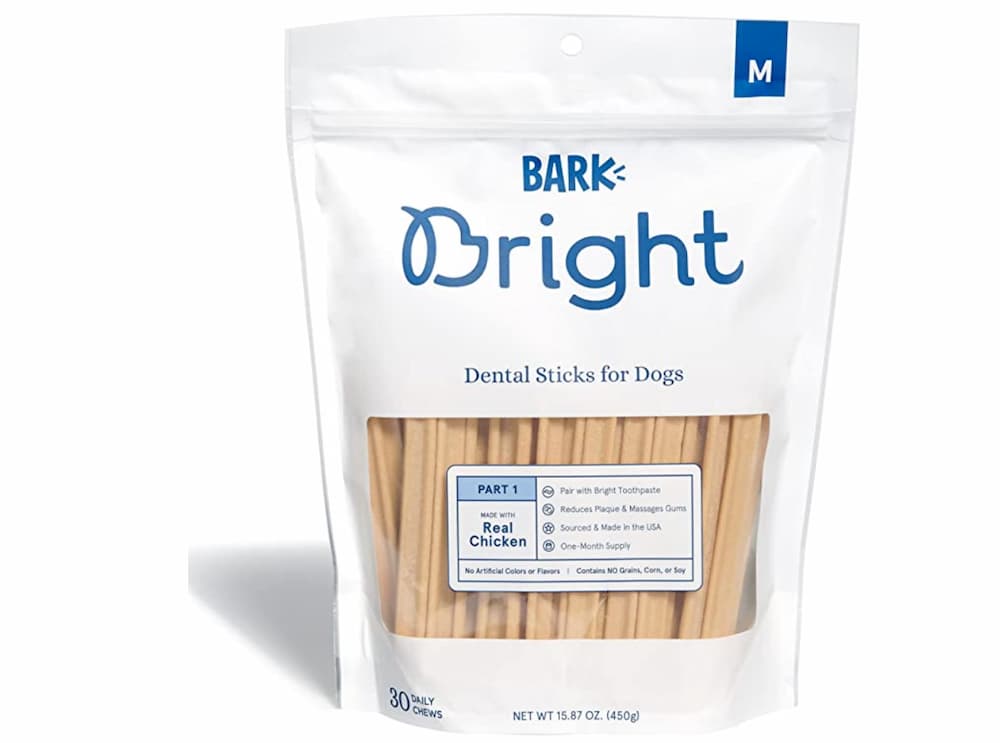
Bark Bright chews are daily, stick-shaped chews you can give your dog to clean and freshen their breath. They help scrub your dog’s teeth and break down debris. Plus, they are made with a tasty chicken flavor that dogs love. You can use these dog breath treats in conjunction with the brand’s enzymatic toothpaste to help clean your dog’s teeth while they chew on the dental sticks.
Highlights
- These dental sticks are safe to give every day
- Can be used with triple enzyme toothpaste to add to the chew to help clean teeth and freshen breath
- Made in the USA
- All ingredients sourced in the U.S. and Finland
- Lactose-free
- Safe for puppies that have their permanent teeth
- Sticks can be broken in half for smaller dogs
Things to Consider
- Not for dogs that are allergic to chicken
- Chews and toothpaste are often sold separately from retailers
Best Large Dog Treats for Bad Breath
Our Pick: Pedigree Dentastix Large Fresh Dog Treats
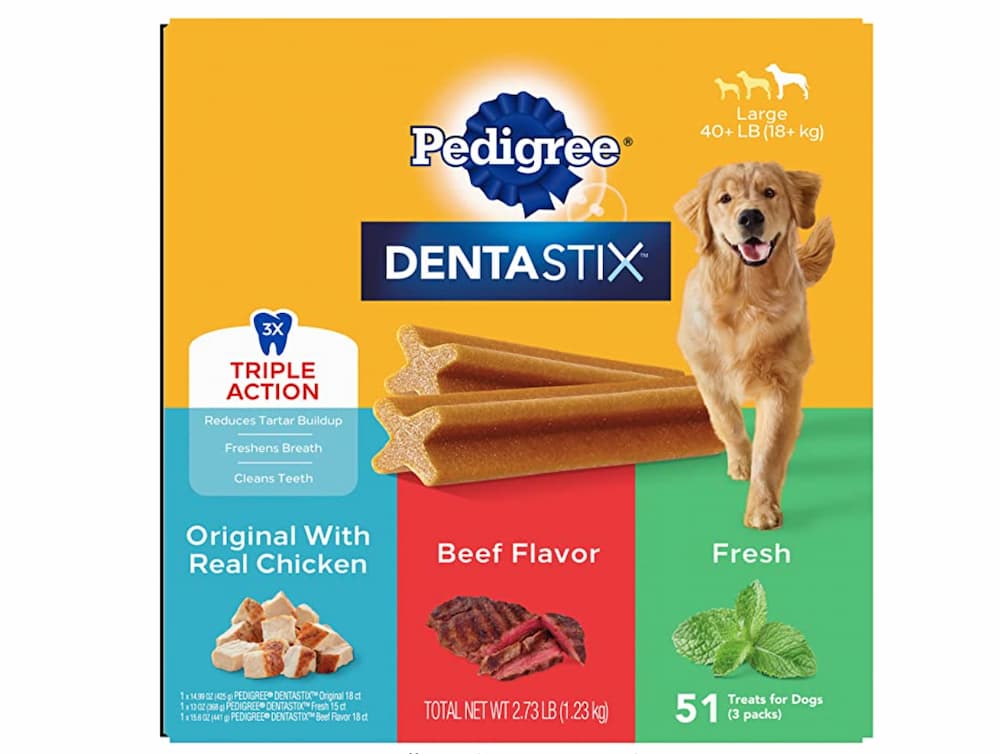
While these treats come in three different sizes, we especially like the large options for bigger breeds. These chewy, textured, X-shaped sticks are great for dogs that love to chew on something for a while. The shape rubs on their teeth while they chew to reduce plaque and tartar build-up. Best of all, it has a patented ingredient in it to help freshen your pup’s breath.
Highlights
- X-shaped chew gives bigger dogs something to work at
- Contain a patented ingredient to help freshen your dog’s breath
- Gives your dog’s breath a minty smell
- Helps to clean your dog’s teeth
- Easy to find at multiple retailers
- Safe to give one to your dog every day
Things to Consider
- Not for puppies
- Make sure fresh drinking water is available while they chew on this stick
- Some dogs had runny stool after eating these treats
Best Grain-Free Dog Treats for Bad Breath
Our Pick: Pet Naturals Breath Bites Dog Chews
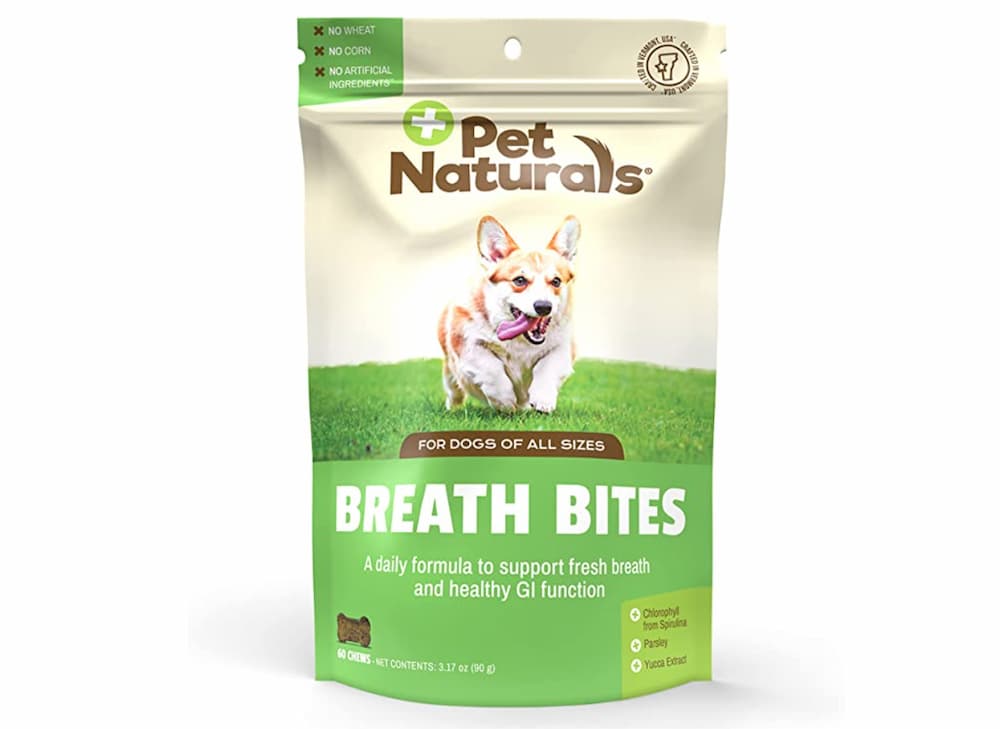
Manufactured in Vermont, these natural breath-freshening treats are free of wheat, corn, and artificial ingredients, making them a great choice for pups with tummy sensitivities. Plus they contain several active ingredients to combat bad breath, including Champignon Mushroom Extract, Yucca Schidigera Extract, and Spirulina. Plus, the treats have cinnamon powder to help promote healthy bacteria balance in your dog’s mouth.
Highlights
- No wheat, corn, or artificial ingredients
- Contain three active ingredients to combat bad breath
- Safe for all breeds
- Tasty chicken liver flavor to appeal to even picky dogs
- Manufactured in Vermont
- National Animal Supplement Council (NASC) quality seal
- Affordably priced
Things to Consider
- May not be safe for pregnant or breeding animals
- Best to give between meals
Best Crunchy Dog Treats for Bad Breath
Our Pick: Bocce’s Bakery Daily Support Dog Treat
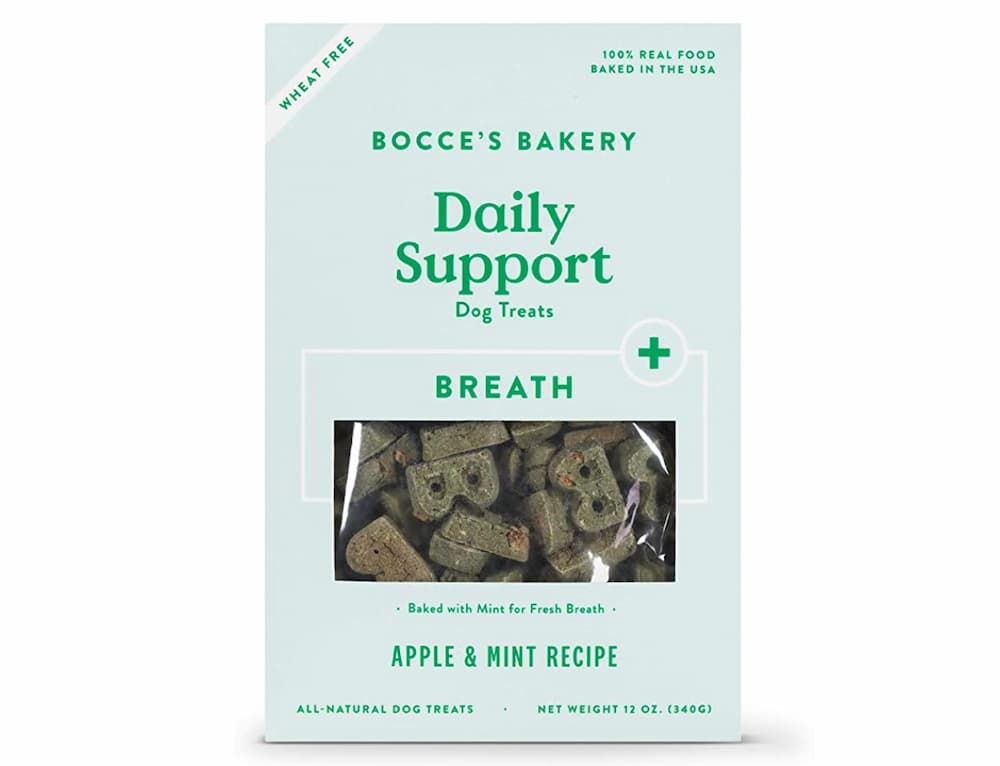
Made in the USA with three recognizable ingredients—oat flour, apple, mint—these wheat-free treats are good for pups with food sensitivities that still need some breath freshening. The treats are crunchy and safe to give to dogs of all breed sizes every day.
Highlights
- Wheat-free and corn-free recipe
- Only three recognizable ingredients
- Made in the USA
- No by-products, fillers, or preservatives
- Safe for small to large breeds
- Affordably priced
Things to Consider
- Fresh breath doesn’t last all day after eating treats
- Doesn’t come in resealable packaging
Best Dog Treats for Puppy Breath
Our Pick: WholeHearted Smart Smiles Dental Treats for Puppies
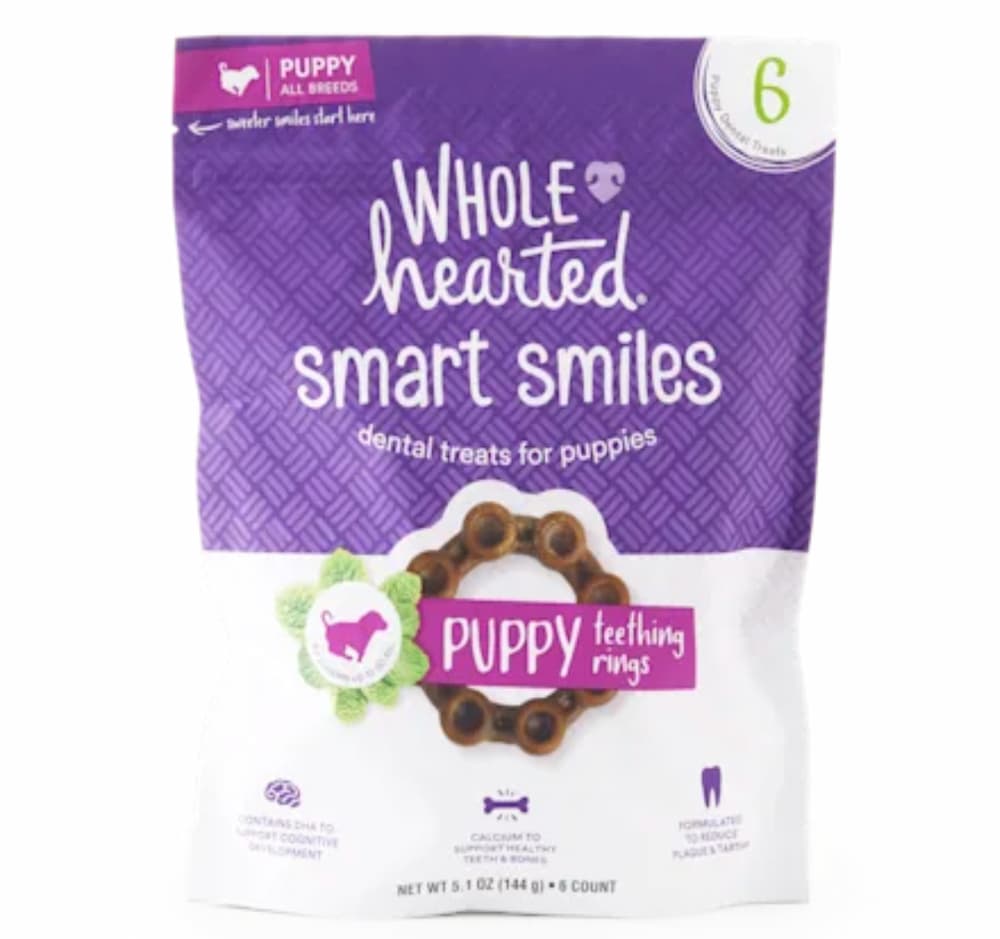
Your teething, chewing puppy isn’t immune from developing bad breath—and these treats should help. Designed specifically for teething puppies, these ring-shaped puppy breath treats allow your dog to chew for long periods on a treat that will freshen their breath with peppermint, while also reducing plaque and tartar. Plus, it contains DHA to support their cognitive development and calcium to support their teeth and bones.
Highlights
- No artificial colors or flavors in these puppy breath treats
- Contains peppermint to freshen breath
- Contains DHA, calcium, and prebiotics to support your puppy’s overall health
- Designed specifically for teething puppies
- The ring-shaped design keeps puppies occupied for a while
Things to Consider
- Not grain-free
- Some puppies don’t like the smell
Best Treats for Senior Dogs with Bad Breath
Our Pick: Ark Naturals Gray Muzzle Brushless Toothpaste Senior Dental Dog Treats
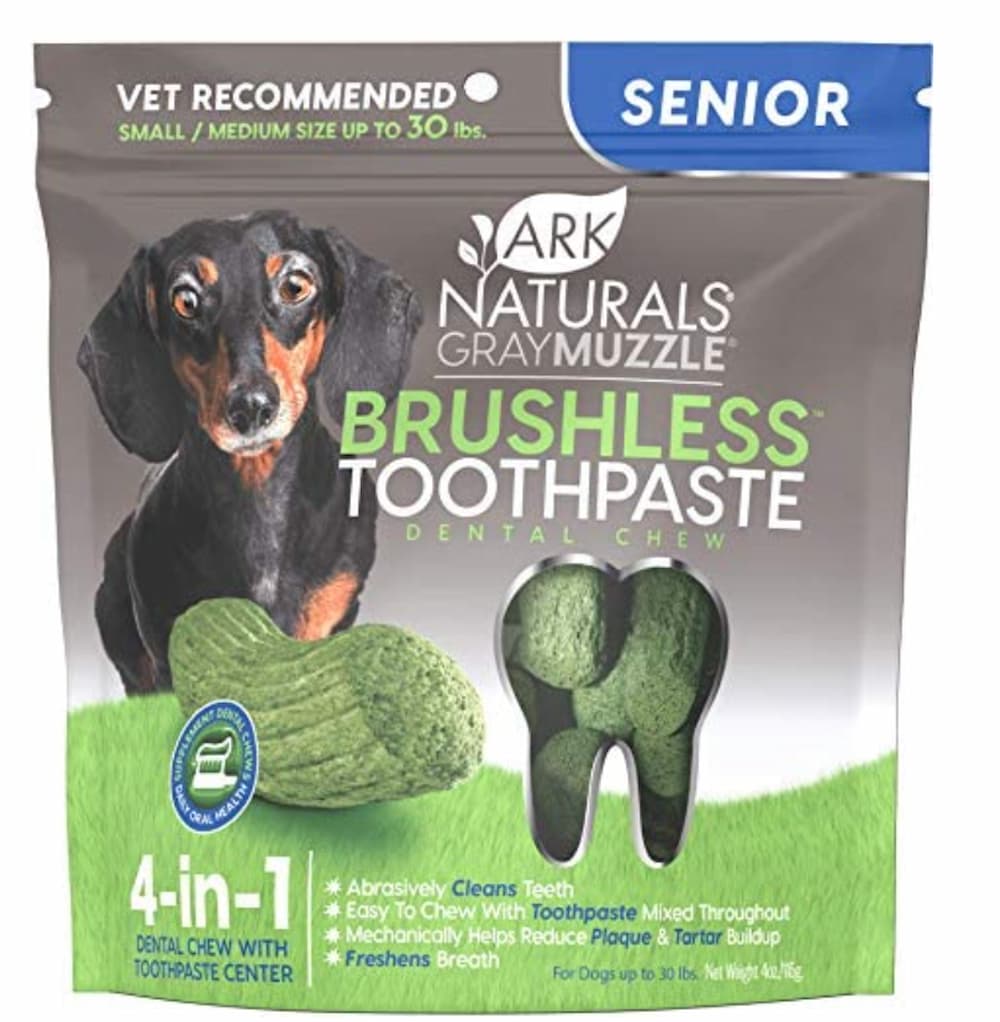
Older dogs have a reputation for bad breath but these all-natural, gluten-free treats can help. They’re designed to be soft enough for older dogs who struggle to chew hard, crunchy treats and they have three ingredients — alfalfa, spearmint, and clove — to help freshen up their stinky breath. Plus, they’re gluten-free and easy to digest.
Highlights
- Made in the USA
- Free of corn, soy, wheat, or artificial colors and preservatives
- Two treats can be given every day
- These soft dog treats for bad breath are ideal for senior dogs that struggle with crunchy, harder treas
- Ingredients fight bacteria and freshen breath
- Available in different sizes for different breeds
- Come in a resealable bag
Things to Consider
- Some dogs do not like the taste
- Soft texture means treats sometimes break or get crushed in shipping
Best Baking Soda Dog Treats for Fresh Breath
Our Pick: Arm & Hammer for Pets Dental Mints for Dogs
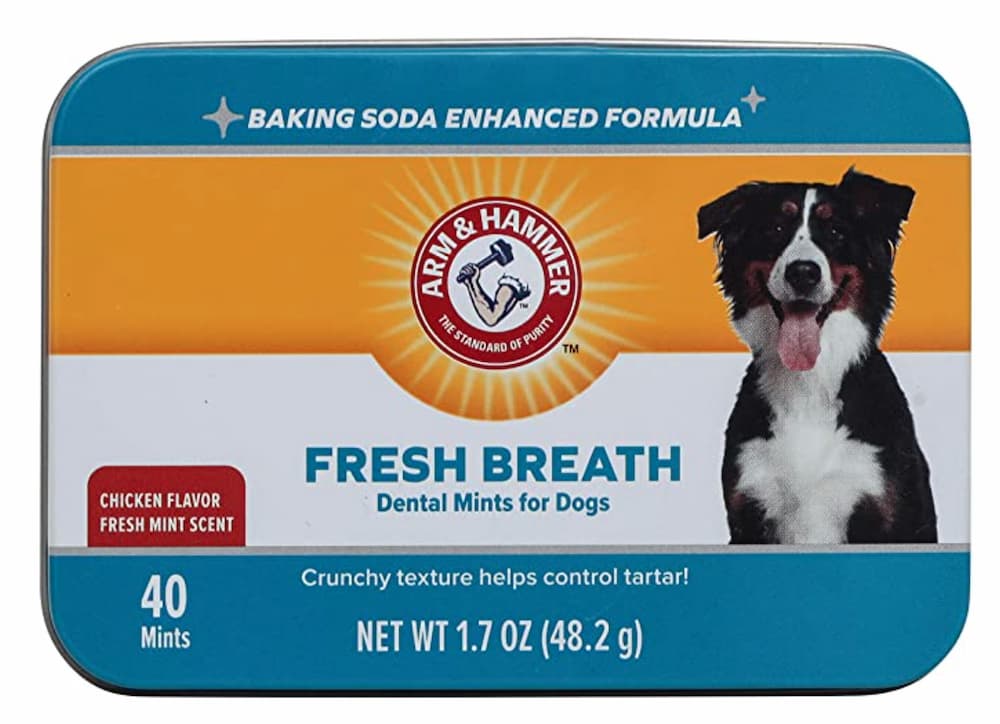
Isn’t it nice, as humans, to just pop a mint in your mouth and instantly have better breath? Well, bad dog breath treats can help our canine pals, too. For example, these treats are essentially breath mints for dogs. They’re made with natural ingredients—including baking soda—and they have a crunchy texture. Plus, your dog will like the taste: they taste like chicken.
Highlights
- Baking soda quickly freshens dogs’ breath
- Safe to give one or two a day as a treat
- Safe for all dogs and puppies
- Crunch, tasty, chicken-flavored treats
- Natural ingredients
- Affordably priced
- Come in a tin for taking on the go
Things to Consider
- Best for smaller dogs due to smaller treat size
Most Affordable Dog Treats for Bad Breath
Our Pick: Milk-Bone Fresh Breath Brushing Chews Daily Dental Dog Treats
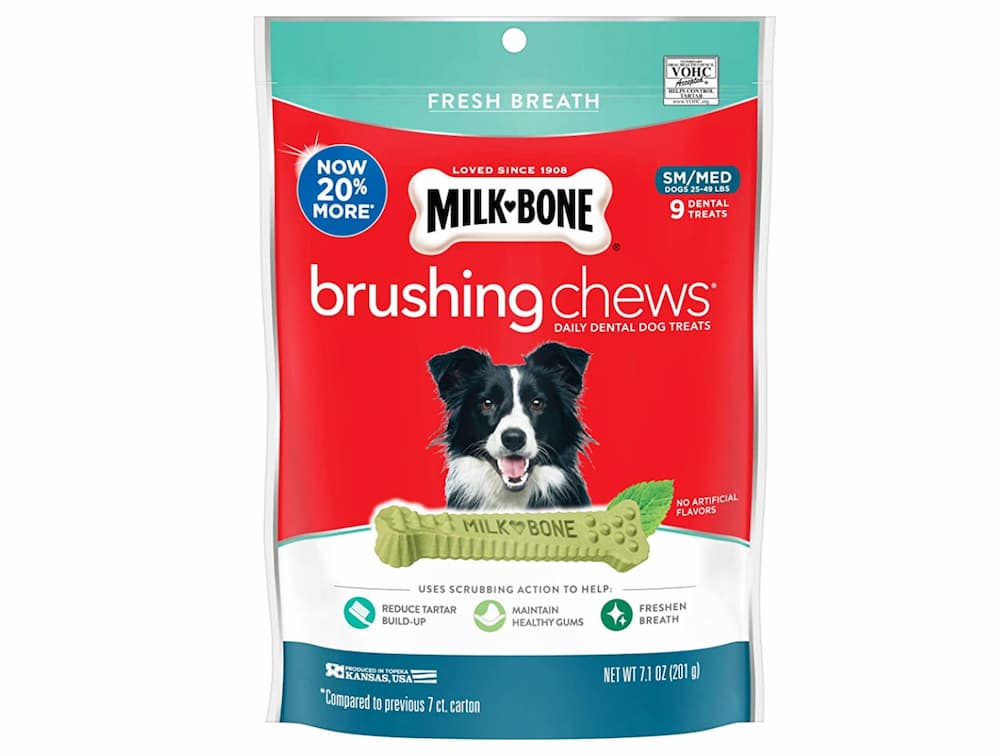
Available in different sizes for different breeds, these treats are super affordable and effective at eliminating bad breath thanks to their spearmint-fresh taste. They are made without artificial flavors, they’re fortified with calcium, and they also have a ridged design to help combat tartar buildup.
Highlights
- Available in mini, small/medium, and large sizes
- Come in a resealable bag
- Have the VOHC Accepted Seal
- These treats for dogs with bad breath contain spearmint
- Fortified with calcium for strong teeth
- Affordable price point
- Made in the USA
Things to Consider
- Some dogs eat these really quickly
What Causes Bad Breath in Dogs?
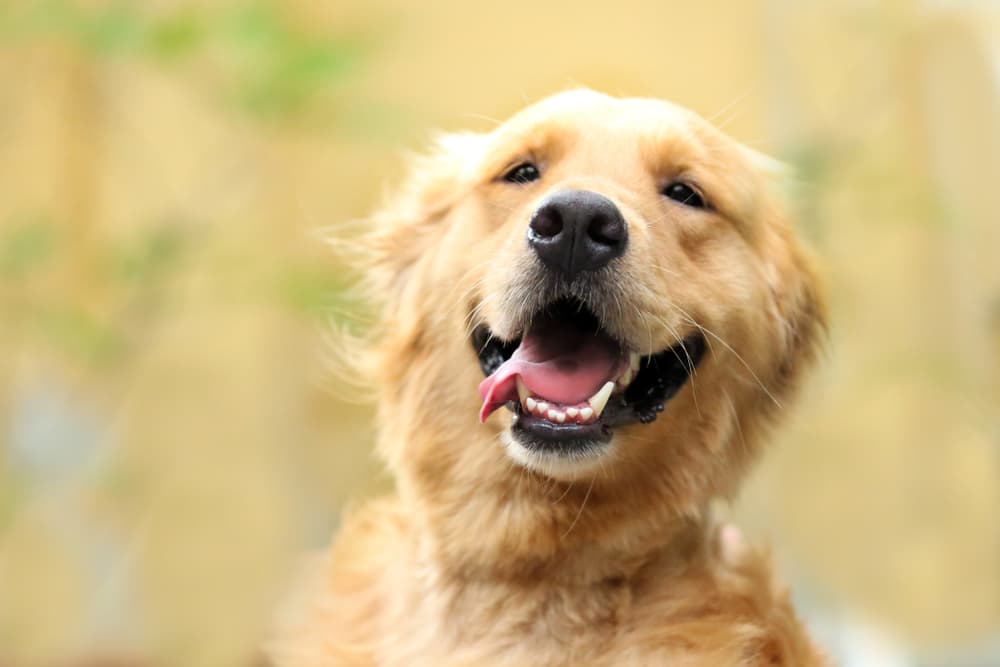
Sometimes bad breath is just the result of whatever your dog ate. For example, if your pup just ate, their breath might smell like their kibble or wet food, especially if they got a little on the fur around their snout.
If they ate something gross (think kitty poop or garbage) that could also be the cause of foul breath in dogs. If your dog’s bad breath is the result of scavenging, you’ll want to find a way to stop that behavior.
However, most causes of bad breath in dogs are actually the result of dirty teeth or dental diseases.
“Dogs are prone to periodontal disease and this periodontal disease causes bad breath,” explains Dr. Brian Evans, founder of Coastal Animal Hospital and clinical director at Dutch. “Inflammation is created around the teeth secondary to bacteria, which secrete toxic substances that damage the supporting structures of the teeth.”
“Over time,” he continues, “this not only leads to bad breath, but also other problems like bone loss around the teeth, tooth root abscesses, and eventually tooth loss.” That’s why it’s important to brush your dog’s teeth because it can mechanically remove the build-up of plaque that coats their teeth.
Sometimes, bad breath in dogs can also be the result of certain health issues, like diabetes, kidney disease, and liver disease. If you’re worried, it’s always a good idea to get your dog checked out by your veterinarian. They can tell you what’s going on — and treat underlying health issues.
Dog Breath: How Dental Treats for Dogs Help
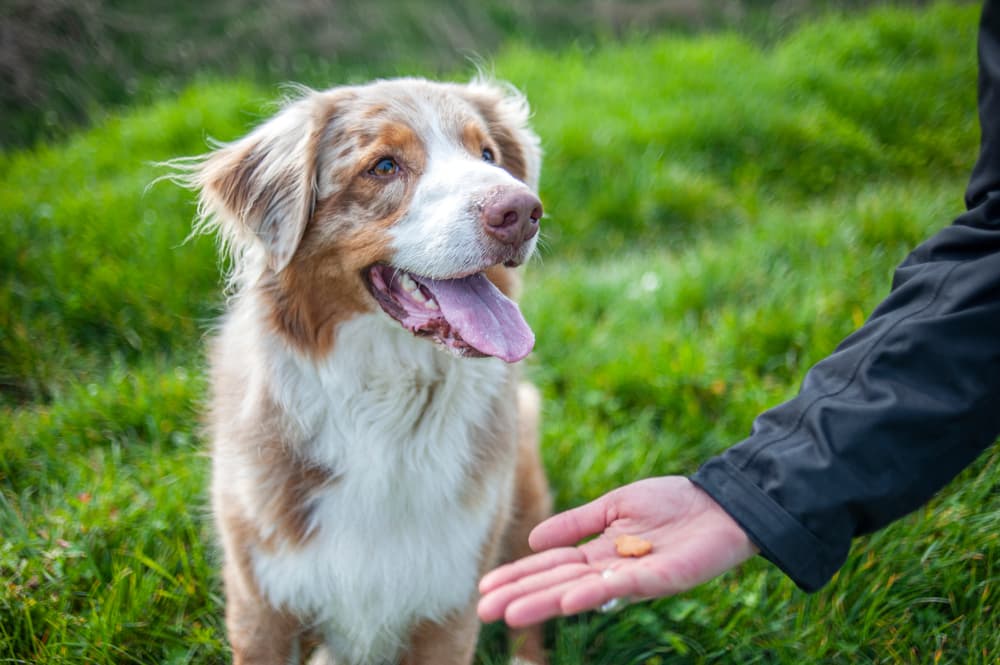
While brushing your dog’s teeth is still the best thing you can do for your dog’s dental health, dental treats and dental chews can help freshen breath in between brushings.
Some of these treats have ingredients—like mint, spearmint, and cinnamon—that can help combat kibble breath. Others are crunchy or have unique textures that physically scrape your dog’s teeth while they chew to help manually remove tartar and plaque. A few of these dog treats for bad breath also have ingredients or enzymes that help break down odor-causing buildup and protect teeth from bacteria.
Remember, dog bones for bad breath can only go so far. Always check with your veterinarian if your dog’s breath doesn’t improve despite your attempts.
Bad Breath Dog Treats: Buying Guide

When you’re looking for dog treats to help freshen a dog’s breath, there are a few things to consider to make sure you’re buying a safe, effective treat. Take these tips into account when shopping.
Check the ingredient label. Look for treats that have ingredients you recognize listed first and be wary of treats that are full of ingredients you don’t recognize. Those extra ingredients could be a bunch of artificial fillers or preservatives. You’ll also want to skip anything that has xylitol in it, as that’s toxic to dogs.
Look for the manufacturing location. In addition to the ingredients, pay attention to whether the treats are manufactured and where their ingredients are sourced. Most reputable brands will manufacture their treats domestically and be clear about where their ingredients come from.
Consider treats with the VOHC seal. “Treats that have the VOHC seal are what I instruct my clients to look for when choosing a treat,” says Dr. Evans. The VOHC seal comes from the veterinary oral health council and products that have this seal have been accepted because they do help minimize plaque and tartar on pets’ teeth. Some companies will also display a NASC quality seal, which means that any supplements have met certain quality and labeling standards.
Decide on Soft Treats vs. Dental Chews. Other than their texture, soft treats and dental chews, there a few difference between these offerings. Soft treats for dogs are used mainly for rewards and in training. Dental chews take longer to work on an are designed to promote dental health in dogs.
Soft dog chews can be given a few times a day, depending on their calorie content. Dental chews, however, are generally fed once daily or as per the packaging instructions, due to caloric intake.
Double check the treat size. Finally, make sure you’re buying the right treat size for your dog. Some smaller chews and crunch treats can be choking hazards if a large dog tries to swallow them whole and smaller dogs may not be able to handle large-sized treats. Recommended size information should be clearly marked on the treat packaging.
Tips for Using Dog Treats for Bad Breath

It’s always best to supervise your dog when you’re giving them a dental treat or chew because that can minimize the chances of them choking on the treat or on large chunks that break off.
Some dog treats for bad breath might also be too hard to chew for some dogs—especially senior pups—and could form sharp edges while they crunch on them. This could hurt a dog’s gums. If you notice your dog’s gums are bleeding a lot from a sharp edge, it’s best you take the treat away, especially if your dog already has inflamed gums.
In addition, says Dr. Evans, “if you are feeding your dog a rawhide-style treat, I recommend removing it once the chew becomes small as they have become lodged in dogs’ throats if they try to swallow them too soon.”
You’ll also want to keep an eye on the calories in your pup’s treats, especially if your dog is having weight issues.
“Weight gain can be one of the biggest issues with dental treats,” says Evans. “Since dental treats need to be given on a daily or every other day basis to be effective, this can be a significant source of calories and needs to be taken into consideration when feeding your dog.”
Work with your veterinarian to determine how to adjust your dog’s food and treat portions to ensure they stay at a healthy weight.

